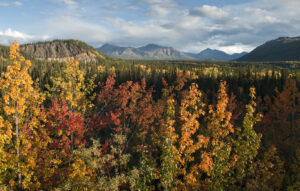by Cliff McCreedy
 Three-dimensional chess is played on three interfacing boards. In Star Trek, the Original Series, Mr. Spock, the Vulcan Science Officer known for his intellectual prowess and command of logic beats the Starship Enterprise’s computer at 3D chess.
Three-dimensional chess is played on three interfacing boards. In Star Trek, the Original Series, Mr. Spock, the Vulcan Science Officer known for his intellectual prowess and command of logic beats the Starship Enterprise’s computer at 3D chess.
What could landscape-scale conservation look like on the 3D chess board? The bottom “board” is the map of ecosystem services such as the delivery of clean water from a forested watershed or sustainable food production from healthy soils in farms. Layer over ecosystem services with the pattern of development and consumption of land and water from residential or commercial development, farming, forestry, and industry. Up on the third layer are state, federal and local government agencies’ jurisdictions and authorities designed to balance these activities, and hopefully conserve healthy land, air and water and wildlife.
Visualization tools using Geographic Information Systems (GIS) and publicly accessible data can assist players in placing their pieces on the chess boards, i.e., prioritize where to focus their land conservation efforts for goals such as maintaining species’ diversity and ecological function. The Maine Appalachian Trail Land Trust developed the “Maine Appalachian Trail Geospatial Information for Conservation” decision-support tool. The Southeast Conservation Adaptation Strategy collaborative developed the Southeast Conservation Blueprint, and the Open Space Institute developed “Opportunity Zones” for the Appalachian Trail Conservancy to locate community-based conservation projects.
Data and enabling policies are essential, of course, but what else will equip us to win 3D landscape chess? First, the approach must address the root sources of problems at the correct scales. Frequently overlooked root causes may be lack of technical capacity at local land use planning agencies and their isolation and lack of coordination with each other at larger landscape scales to solve problems.
There is a wild card to this chess game, however, the chaotic fourth dimension – deeper root causes from human behavior and the people playing the game.
 The first question is who is playing the game? Durable success at landscape scales requires not only technical experts, nongovernmental organizations and agencies, but inviting receptive people and private organizations who live and work on landscapes to participate as co-equals. Ask how can we align around our universal values of quality of life for our families, communities and region? Then forge synergistic partnerships based on these values to sustain the beauty and benefits of healthy lands and water? Biosphere regions engage in these questions with open curiosity to reach shared goals.
The first question is who is playing the game? Durable success at landscape scales requires not only technical experts, nongovernmental organizations and agencies, but inviting receptive people and private organizations who live and work on landscapes to participate as co-equals. Ask how can we align around our universal values of quality of life for our families, communities and region? Then forge synergistic partnerships based on these values to sustain the beauty and benefits of healthy lands and water? Biosphere regions engage in these questions with open curiosity to reach shared goals.
Experiences also show better results when the end user helps design the decision tool upfront, i.e., landowners, communities, managers and agencies. The Smithsonian Conservation Biology Institute (SCBI) took this approach in developing the Changing Landscapes Initiative in Northern Virginia, including the wider region around Shenandoah National Park. SCBI used scenario planning as a framework to engage a diverse group of partners, co-produce a land change decision model and to engage land use planners to adopt it.
The Southern Appalachian Biosphere Region will play this style of 3D chess with a strong emphasis on social science and economics in developing a socioecological vulnerability assessment and resilience plans for both natural and human communities, including underserved and Indigenous communities. Sooner is better for engaging these audiences for the long haul.
Cliff McCreedy is the Science and Stewardship Coordinator at the National Park Service and serves as the federal liaison on the US Biosphere Network Steering Committee. The opinions expressed here are his own.
Editor’s Note: Opinion pieces are sent in by US Biosphere Network community members and do not necessarily represent the beliefs of the Network leadership. More information about submissions can be found here.
Photos, top to bottom: Mr. Spock – Paramount; Denali National Park – NPS



